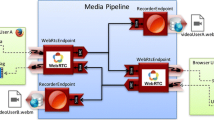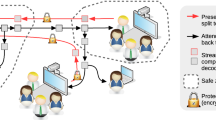Abstract
A major challenge when accessing protected multimedia content in heterogeneous usage environments is the ability to provide acceptable levels of quality of experience to all involving users. Additionally, different levels of protection should be possible to be addressed when manipulating the content towards the quality of experience maximization. This paper describes the use of a context-aware and Digital Rights Management (DRM)-enabled content adaptation platform towards meeting these challenges. The platform was conceived to deliver advanced content adaptation within different application scenarios, among which Virtual Collaboration (VC) was central. Descriptions of use cases implemented by the platform in heterogeneous VC environments are provided. Conducted experiments have highlighted the benefits to users when compared to an operation without the platform. Results of different adaptations suitable to sensed context conditions are also provided and analyzed. A brief description of the platform functionality is included together with pointers to additional information.
















Similar content being viewed by others
Abbreviations
- AA:
-
Adaptation authorizer
- ADE:
-
Adaptation decision engine
- AE:
-
Adaptation engine
- AES:
-
Adaptation engine suite
- AQoS:
-
Adaptation quality of Service
- CAO:
-
Context aware ontology
- CS:
-
Classification scheme
- CxP:
-
Context provider
- DIA:
-
Digital item adaptation
- DL:
-
Description logic
- DRM:
-
Digital rights management
- IROI:
-
Interactive region of interest
- GPS:
-
Global positioning system
- MDS:
-
Multimedia description schemes
- MOS:
-
Mean opinion score
- MULTICAO:
-
Multimedia context aware ontology
- OWL:
-
Web ontology language
- REL:
-
Rights expression language
- ROI:
-
Region of interest
- SNR:
-
Signal-to-noise ratio
- SWRL:
-
Semantic web rule language
- UED:
-
Usage environment description
- VC:
-
Virtual collaboration
References
Andrade MT (2007) Architectural support for ubiquitous access to multimedia content. Ph.D. Thesis, Faculty of Engineering of the University of Porto
Andrade MT, Kodikara Arachchi H, Nasir S, Dogan S, Uzuner H, Kondoz AM, Delgado J, Rodriguez E, Carreras A, Masterton T, Craddock R (2007) Using context to assist the adaptation of protected multimedia content in virtual collaboration applications. In IEEE/ICT Proceedings of the 3rd International Conference on Collaborative Computing (CollaborateCom 2007). New York
Burnett I, Pereira F, Walle R, Koenen R (eds) (2006) The MPEG-21 book. Wiley
Carreras A, Andrade MT, Masterton T, Kodikara Arachchi H, Barbosa V, Dogan S, Delgado J, Kondoz AM (2009) Contextual information in virtual collaboration systems beyond current standards. In Proceedings of the 10th Int. Workshop on Image Analysis for Multimedia Interactive Services (WIAMIS 2009). London, pp 209–213
Carreras A, Delgado J, Rodriguez E, Barbosa V, Andrade M, Kodikara Arachchi H, Dogan S, Kondoz A (2010) A platform for context-aware and digital rights management-enabled content adaptation. IEEE Multimedia 17(2):74–89
Chaari T, Laforest F, Celentano A (2006) Adaptation in context-aware pervasive information systems: the SECAS project. Int J Pervasive Comput Commun 2(2)
Dey AK (2000) Providing architectural support for building context-aware applications. Ph. D. Thesis, College of Computing, Georgia Institute of Technology
Guo Y, Li H, Wang Y (2005) SVC/AVC loss simulator donation. JVT input document JVT-Q069
Horrocks I, Patel-Schneider PF, Boley H, Tabet S, Grosof B, Dean M (2004) SWRL: a semantic web rule language combining OWL and RuleML, W3C member submission, May 2004. [Online]. Available: http://www.w3.org/Submission/SWRL/
Jannach D, Leopold K, Timmerer C, Hellwagner H (2006) A knowledge-based framework for multimedia adaptation. Journal of Applied Intelligence, Special Issue on Innovations in Applied Artificial Intelligence 24(2):109–125
Kofler I, Timmerer C, Hellwagner H, Hutter A, Sanahuja F (2007) Efficient MPEG-21-based adaptation decision-taking for scalable multimedia content. In Proceedings of the 14th Multimedia Computing and Networking Conference (MMCN), San Jose
Kofler I, Seidl J, Timmerer C, Hellwagner H, Djama I, Ahmed T (2008) Using MPEG-21 for cross-layer multimedia content adaptation. J Signal Image Video Process (SIVP) 2(4):355–370
Kosch H, Timmerer C (guest editors) (2009) Multimedia metadata and semantic management. In IEEE Computer Society Computing Now
Lee K-Ch, Kim J-H, Lee J-H, Lee K-M (2007) Implementation of ontology based context-awareness framework for ubiquitous environment. In Proceedings of the IEEE International Conference on Multimedia and Ubiquitous Engineering, Seoul, Korea
Liu D, Meng XW, Chen JL (2008) A framework for context-aware service recommendation. In Proceedings of the International conference on Advanced Computing Technologies (ICACT ’08), Hyderabad, India
Lopez F, Jannach D, Martinez JM, Timmerer C, Hellwagner H, Garcia N (2008) Multimedia adaptation decisions modelled as non-deterministic operations. In Proceedings of the 9th International Workshop on Image Analysis for Multimedia Interactive Services (WIAMIS’08), Klagenfurt
López F, Martinez JM, Garcia N (2009) CAIN-21: an extensible and metadata-driven multimedia adaptation engine in the MPEG-21 framework. In: Chua T-S et al (eds) Lectures notes in computer science. Springer Verlag, vol. 5887, pp 114–125, 4th International Conference on Semantic and Digital Media Technologies (SAMT 2009), Graz, Austria, December 2–4, 2009
McGuinness DL, Harmelen FV (2004) Web Ontology Language (OWL): Overview. W3C Recommendation. [Online]. Available: http://www.w3.org/TR/2004/REC-owl-features-20040210/
Mpeg 2010. [Online]. Available: http://www.chiariglione.org/mpeg/
Mpeg-21 Part 1 2004. Information Technology—Multimedia Framework (MPEG-21)—Part 1: Vision, Technologies and Strategy, ISO/IEC Standard.
Mpeg-7 Part 5 2003. Information Technology—Multimedia content description interface—Part 5: Multimedia description schemes, ISO/IEC Standard.
Mpeg-21 Part5 2004. Information Technology—Multimedia Framework (MPEG-21)—Part 5: Rights Expression Language, ISO/IEC Standard
Mpeg-21 Part7 2007. Information Technology—Multimedia Framework (MPEG-21)—Part 7: Digital Item Adaptation, ISO/IEC Standard
Multicao 2010. [Online]. Available: http://www.visnet-noe.org/dokuwiki/doku.php?id=context-based_adaptation:multicao
OWL (2004) Web Ontology Language (OWL): Overview, W3C Recommendation. [Online]. Available: http://www.w3.org/TR/owl-features/.
Pellet (2010) Pellet: The Open Source OWL DL Reasoner. Clark & Parsia. [Online]. Available: http://clarkparsia.com/pellet/
Preuveneers D, Vandewoude Y, Rigole P, Ayed D, Berber Y (2006) Context-aware adaptation for component-based pervasive computing system. In Proceedings of the 4th International Conference on Pervasive Computing, Dublin, Ireland, pp 125–128
Qin W, Shi Y, Suo Y (2007) Ontology-based context-aware middleware for smart spaces. Tsinghua Sci Technol 12(6):707–713
Serrano JM, Serrat J, Strssner J (2007) Ontology-based reasoning for supporting context-aware services on autonomic networks. In Proceedings of the IEEE International Conference on Communications 2007 (ICC-2007), Glasgow
Timmerer C, Vetro A, Hellwagner H (2008) MPEG-21 digital item adaptation. In: Furht B (ed) Encyclopedia of multimedia, 2nd edn. Springer, pp 457–463
Vetro A, Timmerer C (2005) Digital item adaptation: overview of standardization and research activities. IEEE Trans Multimedia 7(3):418–426
VISNET II Wiki (2010) [Online]. Available: http://www.visnet-noe.org/dokuwiki/.
W3C 2010. World Wide Web Consortium [Online]. Available: http://www.w3.org/
Wang X, DeMartini T, Wragg B, Paramasivam M, Barlas C (2005) The MPEG-21 rights expression language and rights data dictionary. IEEE Trans Multimedia 7(3):408–416
Wenger S (2002) Error patterns for internet experiments. ITU-T VCEG Q15-I-16r1
Acknowledgments
The work presented was partially developed within VISNET II, a European Network of Excellence (http://www.visnet-noe.org), funded under the European Commission IST FP6 programme.
Author information
Authors and Affiliations
Corresponding author
Rights and permissions
About this article
Cite this article
Andrade, M.T., Dogan, S., Carreras, A. et al. Advanced delivery of sensitive multimedia content for better serving user expectations in Virtual Collaboration applications. Multimed Tools Appl 58, 633–661 (2012). https://doi.org/10.1007/s11042-011-0749-6
Published:
Issue Date:
DOI: https://doi.org/10.1007/s11042-011-0749-6




